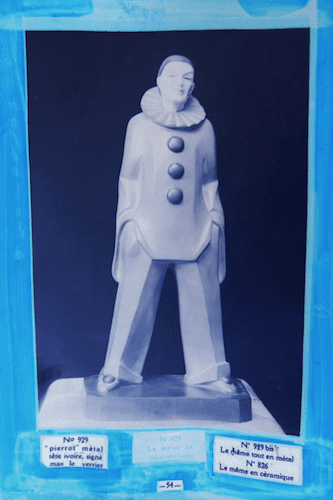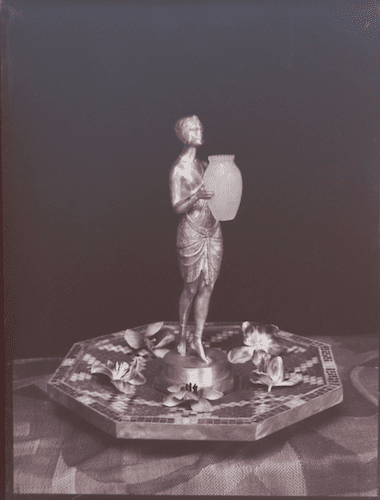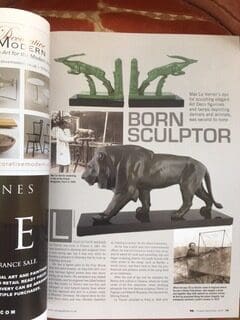My Amazing Le Verrier Collection
My friend, the great grandson of Max, informs me that he is currently writing a new book about sculptors who influenced the 20th Century artistic movement with details of many of the great creators including Le Faguays, Guerbe and Bouraine, and with a special section about Le Verrier.
Max Le Verrier is one of the most prolific sculptors of the art deco period.
Born 29th January 1891 he was sent to several boarding schools as a child and eventually he was sent to study Agriculture against his will by his father but returned to Paris in 1907 and would do odd jobs just to avoid having to work in Agriculture. After a brief and relatively unsuccessful move to London in 1909 Max would return to France. It was then that he decided to gain a pilots licence which would ultimately allow him to fly with the French bomber Squadron in World War 1 from 1915. Just a few month later Max was shot down in a dogfight with two German planes and declared missing by the French authorities while being held in captivity by the Germans. He received the French military medal and the Croix de Guerre 1914-1918. It was during his captivity that he requested modelling clay and began sculpting and depicting his fellow prisoners, some of whom were also artists. In 1917 Max was a part of a prisoner exchange in Switzerland and was interned at the École des Beaux-Arts in Geneva where he met and became lifelong friends and collaborators with Pierre Le Faguays and Marcel Bouraine.
Upon the end of the war Max returned to Paris, married Jeanne Hubrecht in 1921 and had two sons. Not long after that he inherited a foundry and set up a base for his work. His early animal works were signed Artus. Working in mainly bronze and ivory, zinc, terracotta and ceramics, Max was not only to cast his own but other artists works, including his friends Bouraine and Le Faguays.
His female figures became particularly well known, including his Clarte statue due to their symmetry and flexible and athletic bodies. He won a gold medal at the International Exhibition of Modern Decorative and Industrial Arts held in Paris in 1925 and displayed at the Paris World Exhibition in 1937.
During World War 2 Max allowed his house to be used as a dead post box for the Resistance in order to allow restricted communications pass between other members of the resistance. This was incredibly risky in German occupied Paris and eventually Max attracted the attentions of, and was caught by the Vichy regime who were set up to quash the resistance movement and handed over to the German occupiers who did not hold him for long. He immediately returned to his house and was almost caught 4 days later but was able to evade capture by escaping through a hidden door along with other people in the property including Jewish workers. Max eventually made his way to his waiting family in the Gers region of southern France using false papers.
On the site of the former family home is a plaque that reads “Max Le Verrier 1891 – 1973. Sculptor – Art Editor. Built and lived in this house from 1933 to 1973. This place was a relay of the resistance from 1941 to 1944”.
Returning to Paris towards the end of the war, Max found his house and foundry looted. Once the war was over, he went back to work and worked until his death in 1973. He was buried in a cemetery in Fontenay-lès-Briis near his friend Pierre Le Faguays who had died over a decade earlier.

Max Le Verrier’s most famous statue is probably Clarte. This model was made in 4 different sizes. A small table top lamp called Lueur lumineusse as she measures 15 inches (38cm) high. This same size one was also made as statue known as Lueur holding an onyx ball instead of a globe. Next size up was Lumina and she measured 25.5 inches (65cm) high made as a table lamp. Then was the 33.5 inches (85cm) high Clarte table lamp.
(Right) the original photograph of Max in his studio sculpting the original Clarte.

Finally there was a life size bronze version (I am honoured to own one). It measures 5 foot 7 inches (1.7 mtrs) high, and was made in very limited quantities and exceedingly rare.
In 1962 Jean-Paul Le Verrier – the son of Max produced 3 fibreglass versions of the life size Clarte. These were hired out to film studios as they were lighter to carry than the bronze versions which are extremely heavy and expensive. I also own one of the fibreglass models and the family own another.
Not only do I own many of the Le Verrier statues but also have many items from the original archives of the atelier.
The family home South of Paris was sold in early 2017. At the house was a barn which housed many of the original Le Verrier items, filing cabinets and original moulds. Some of these items were put into auction in Paris and I purchased many of the items from the auction and many items from the family – including all the unsold items from the auction.
These items included, decoupage pictures from magazines mounted on card stamped with the Le Verrier stamp. These were pictures of ladies in theatrical poses which were inspiration for some of the statues made by Max.
Original cards and documents with his photo ID. Including a copy of his birth certificate and driving licence. Along with his original 3 berets and some wallets.
Moulds – I have several original plaster moulds which still contain the statues being moulded. The statues cannot be removed unless the moulds are broken. I do not want to do this as I believe its an important part of the Le Verrier history and they really should be in a museum.


Original moquettes – An original and unique plaster bust of one of Max favourite models. The original moquette of the Alsatian dog (one of Max dogs) and the terracotta made from the original model.




Letters of proprietary – I have many of the original letters and documents signed in ink by the artists who sold the statues to the Le Verrier foundry. Signed by such artists as – Bouraine, Le Faguays, Guerbe, Lemoine, Charles and Galliard. The artist would create the statue in a plasterlene material and sell it to the foundry.





Both Max and his son Jean-Paul Le Verrier were members of the French resistance and saved many lives. Here are some of the original posters designed and printed by Jean-Paul for the resistance and also various artworks by Jean-Paul Le Verrier.









Among several artworks by Max are some original sketches for statues that were never put into production. Signed and dated by Max Le Verrier. Now in my private collection and not for sale.



I also have many of the original negative photos both on film and on glass of the statues, lamps and bookends that were produced. These have also come from the atelier. Some show drawings that were never produced and the others show variations on the statues and forms. Some of the statues were also produced as vide poches with a metal tray base.















Max Le Verrier’s plasterlene – the box of original plasterlene which belonged to Max himself. This was given to me as a gift by the family and is probably one of my favourite items I have from the Le Verrier collection as it was used by Max himself and still has his fingerprints in it. Again, I think this should be in a museum.

I worked on a magazine article about Max Le Verrier for VE (Vintage Explorer) magazine where I also discussed some of the original items I have acquired over the years – issue 47 August/September 2019.



For further information about Max, see the Max Le Verrier section in our “Information on Artists” page.
Next Blog: Exclusive Offer – Limited Edition Cubist Clown by Lindsey B
Back to all blogs